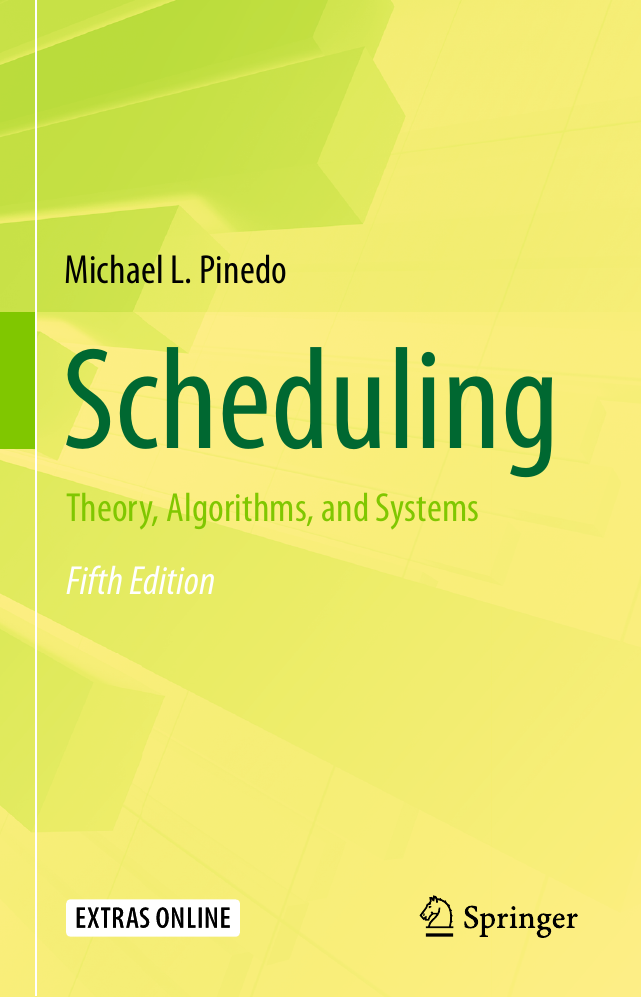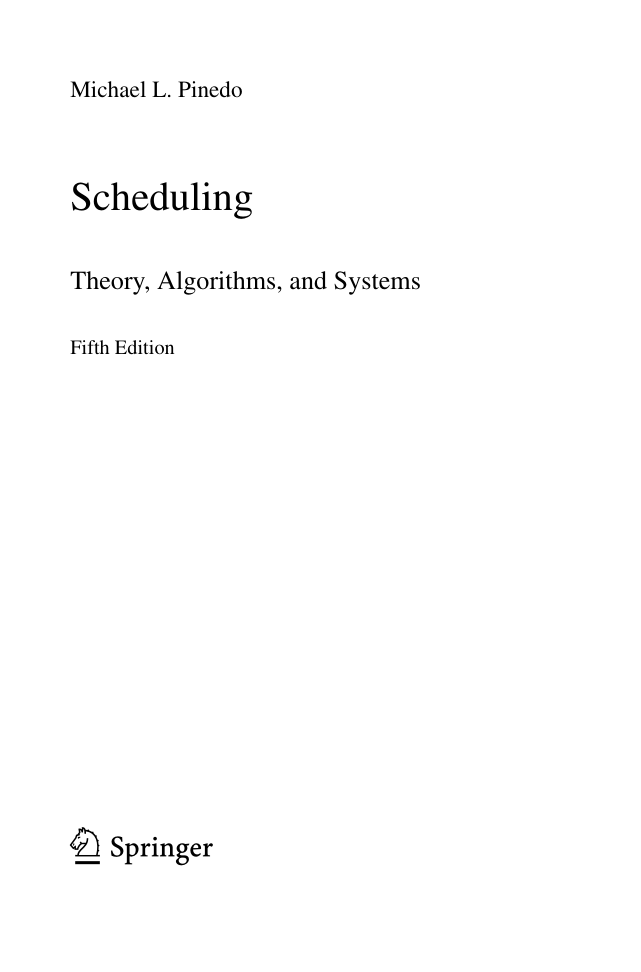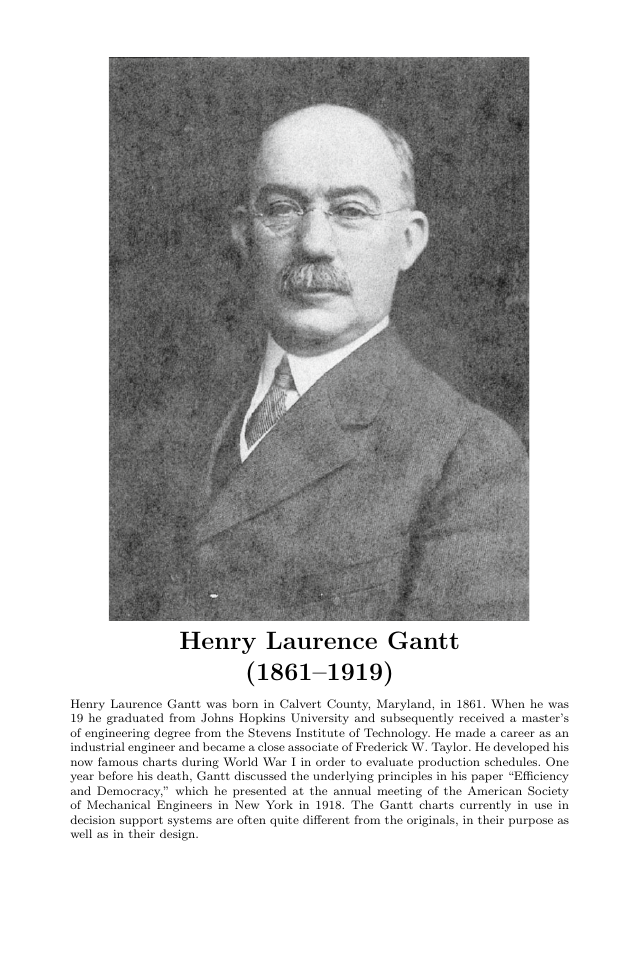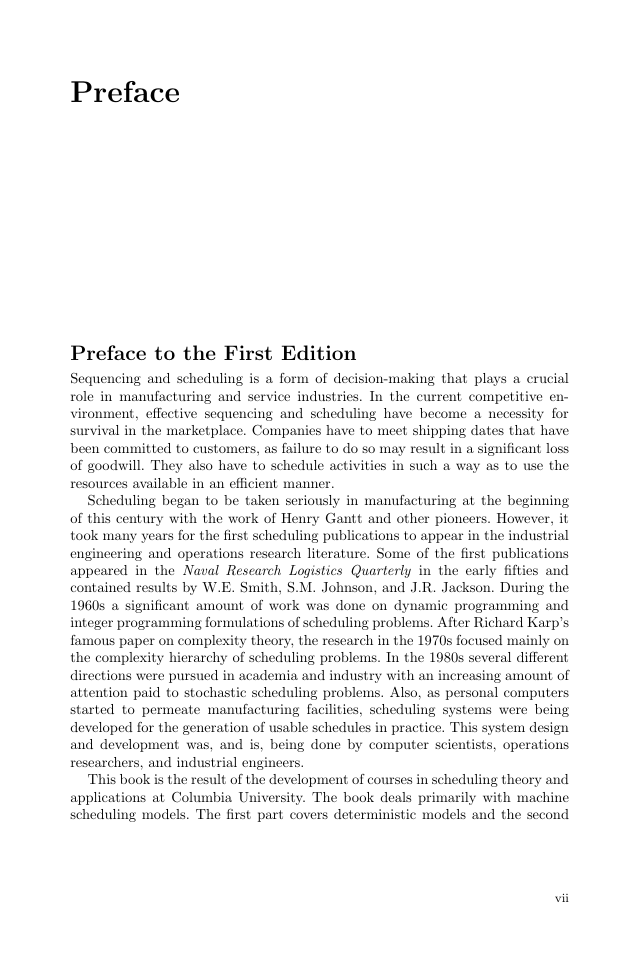Preface
Preface to the First Edition
Preface to the Second Edition
Preface to the Third Edition
Preface to the Fourth Edition
Preface to the Fifth Edition
Contents
Supplementary Electronic Material
1 Introduction
1.1 The Role of Scheduling
1.2 The Scheduling Function in an Enterprise
1.3 Outline of the Book
Part I Deterministic Models
2 Deterministic Models: Preliminaries
2.1 Framework and Notation
2.2 Examples
2.3 Classes of Schedules
2.4 Complexity Hierarchy
3 Single Machine Models (Deterministic)
3.1 The Total Weighted Completion Time
3.2 The Maximum Lateness
3.3 The Number of Tardy Jobs
3.4 The Total Tardiness - Dynamic Programming
3.5 The Total Tardiness - An Approximation Scheme
3.6 The Total Weighted Tardiness
3.7 Online Scheduling
3.8 Discussion
4 Advanced Single Machine Models (Deterministic)
4.1 The Total Earliness and Tardiness
4.2 Primary and Secondary Objectives
4.3 Multiple Objectives: A Parametric Analysis
4.4 The Makespan with Sequence Dependent SetupTimes
4.5 Job Families with Setup Times
4.6 Batch Processing
4.7 Discussion
5 Parallel Machine Models (Deterministic)
5.1 The Makespan without Preemptions
5.2 The Makespan with Preemptions
5.3 The Total Completion Time without Preemptions
5.4 The Total Completion Time with Preemptions
5.5 Due Date Related Objectives
5.6 Online Scheduling
5.7 Discussion
6 Flow Shops and Flexible Flow Shops (Deterministic)
6.1 Flow Shops with Unlimited Intermediate Storage
6.2 Flow Shops with Limited Intermediate Storage
6.3 Proportionate Flow Shops with Unlimited and Limited Intermediate Storage
6.4 Flexible Flow Shops with Unlimited Intermediate Storage
6.5 Discussion
7 Job Shops (Deterministic)
7.1 Disjunctive Programming and Branch-and-Bound
7.2 The Shifting Bottleneck Heuristic and the Makespan
7.3 The Shifting Bottleneck Heuristic and the Total Weighted Tardiness
7.4 Constraint Programming and the Makespan
7.5 Discussion
8 Open Shops (Deterministic)
8.1 The Makespan without Preemptions
8.2 The Makespan with Preemptions
8.3 The Maximum Lateness without Preemptions
8.4 The Maximum Lateness with Preemptions
8.5 The Number of Tardy Jobs
8.6 Discussion
Part II Stochastic Models
9 Stochastic Models: Preliminaries
9.1 Framework and Notation
9.2 Distributions and Classes of Distributions
9.3 Stochastic Dominance
9.4 Impact of Randomness on Fixed Schedules
9.5 Classes of Policies
10 Single Machine Models (Stochastic)
10.1 Arbitrary Distributions without Preemptions
10.2 Arbitrary Distributions with Preemptions: the Gittins Index
10.3 Likelihood Ratio Ordered Distributions
10.4 Exponential Distributions
10.5 Discussion
11 Single Machine Models with Release Dates (Stochastic)
11.1 Arbitrary Release Dates and Arbitrary Processing Times without Preemptions
11.2 Priority Queues, Work Conservation, and Poisson Releases
11.3 Arbitrary Releases and Exponential Processing Times with Preemptions
11.4 Poisson Releases and Arbitrary Processing Times without Preemptions
11.5 Discussion
12 Parallel Machine Models (Stochastic)
12.1 The Makespan and Total Completion Time withoutPreemptions
12.2 The Makespan and Total Completion Time with Preemptions
12.3 Due Date Related Objectives
12.4 Bounds Obtained through Online Scheduling
12.5 Discussion
13 Flow Shops, Job Shops and Open Shops (Stochastic)
13.1 Stochastic Flow Shops with Unlimited Intermediate Storage
13.2 Stochastic Flow Shops with Blocking
13.3 Stochastic Job Shops
13.4 Stochastic Open Shops
13.5 Discussion
Part III Scheduling in Practice
14 General Purpose Procedures for Deterministic Scheduling
14.1 Dispatching Rules
14.2 Composite Dispatching Rules
14.3 Local Search: Simulated Annealing and Tabu-Search
14.4 Local Search: Genetic Algorithms
14.5 Ant Colony Optimization
14.6 Discussion
15 More Advanced General Purpose Procedures
15.1 Beam Search
15.2 Decomposition Methods and Rolling Horizon Procedures
15.3 Constraint Programming
15.4 Market-Based and Agent-Based Procedures
15.5 Procedures for Scheduling Problems with Multiple Objectives
15.6 Discussion
16 Modeling and Solving Scheduling Problems in Practice
16.1 Scheduling Problems in Practice
16.2 Cyclic Scheduling of a Flow Line
16.3 Scheduling of a Flexible Flow Line with Limited Buffers and Bypass
16.4 Scheduling of a Flexible Flow Line with Unlimited Buffers and Setups
16.5 Scheduling a Bank of Parallel Machines with Jobs having Release Dates and Due Dates
16.6 Discussion
17 Design and Implementation of Scheduling Systems: Basic Concepts
17.1 Systems Architecture
17.2 Databases, Object Bases, and Knowledge-Bases
17.3 Modules for Generating Schedules
17.4 User Interfaces and Interactive Optimization
17.5 Generic Systems vs. Application-Specific Systems
17.6 Implementation and Maintenance Issues
18 Design and Implementation of Scheduling Systems: More Advanced Concepts
18.1 Robustness and Reactive Decision-Making
18.2 Machine Learning Mechanisms
18.3 Design of Scheduling Engines and AlgorithmLibraries
18.4 Reconfigurable Systems
18.5 Web-Based Scheduling Systems
18.6 Discussion
19 Examples of System Designs and Implementations
19.1 SAP's Production Planning and Detailed Scheduling System
19.2 IBM's Independent Agents Architecture
19.3 Real Time Dispatching and Agent Scheduling at AMD
19.4 ASPROVA Advanced Planning and Scheduling
19.5 Preactor Planning and Scheduling Systems
19.6 ORTEMS' Agile Manufacturing Suite
19.7 LEKIN - A System Developed in Academia
19.8 Discussion
20 What Lies Ahead?
20.1 Theoretical Research
20.2 Applied Research
20.3 Systems Development
Appendices
Mathematical Programming: Formulations and Applications
A.1 Linear Programming Formulations
A.2 Integer Programming Formulations
A.3 Bounds, Approximations, and Heuristics Based on Linear Programming
A.4 Disjunctive Programming Formulations
Deterministic and Stochastic Dynamic Programming
B.1 Deterministic Dynamic Programming
B.2 Stochastic Dynamic Programming
Constraint Programming
C.1 Constraint Satisfaction
C.2 Constraint Programming
C.3 An Example of a Constraint Programming Language
C.4 Constraint Programming vs. Mathematical Programming
Complexity Theory
D.1 Preliminaries
D.2 Polynomial Time Solutions versus NP-Hardness
D.3 Examples
D.4 Approximation Algorithms and Schemes
Complexity Classification of Deterministic SchedulingProblems
Overview of Stochastic Scheduling Problems
Selected Scheduling Systems
The Lekin System
H.1 Formatting of Input and Output Files
H.2 Linking Scheduling Programs
References
Author Index
Subject Index
















 2023年江西萍乡中考道德与法治真题及答案.doc
2023年江西萍乡中考道德与法治真题及答案.doc 2012年重庆南川中考生物真题及答案.doc
2012年重庆南川中考生物真题及答案.doc 2013年江西师范大学地理学综合及文艺理论基础考研真题.doc
2013年江西师范大学地理学综合及文艺理论基础考研真题.doc 2020年四川甘孜小升初语文真题及答案I卷.doc
2020年四川甘孜小升初语文真题及答案I卷.doc 2020年注册岩土工程师专业基础考试真题及答案.doc
2020年注册岩土工程师专业基础考试真题及答案.doc 2023-2024学年福建省厦门市九年级上学期数学月考试题及答案.doc
2023-2024学年福建省厦门市九年级上学期数学月考试题及答案.doc 2021-2022学年辽宁省沈阳市大东区九年级上学期语文期末试题及答案.doc
2021-2022学年辽宁省沈阳市大东区九年级上学期语文期末试题及答案.doc 2022-2023学年北京东城区初三第一学期物理期末试卷及答案.doc
2022-2023学年北京东城区初三第一学期物理期末试卷及答案.doc 2018上半年江西教师资格初中地理学科知识与教学能力真题及答案.doc
2018上半年江西教师资格初中地理学科知识与教学能力真题及答案.doc 2012年河北国家公务员申论考试真题及答案-省级.doc
2012年河北国家公务员申论考试真题及答案-省级.doc 2020-2021学年江苏省扬州市江都区邵樊片九年级上学期数学第一次质量检测试题及答案.doc
2020-2021学年江苏省扬州市江都区邵樊片九年级上学期数学第一次质量检测试题及答案.doc 2022下半年黑龙江教师资格证中学综合素质真题及答案.doc
2022下半年黑龙江教师资格证中学综合素质真题及答案.doc